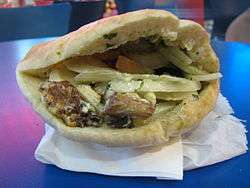Sabich
Sabich or sabih (Hebrew: סביח [saˈbiχ]) is an Israeli sandwich based on a traditional Iraqi Jewish dish prepared for Shabbat. It consists of pita or laffa stuffed with fried eggplant, hard boiled eggs, Israeli salad, parsley, amba and tahini sauce.[1]
 | |
| Course | Breakfast (among Iraqi Jews) and Street food (entire country), Sandwich |
|---|---|
| Place of origin | Israel |
| Main ingredients | Traditionally laffa, although Israeli pita is often used, eggplant, hard boiled eggs, Israeli salad, amba, parsley, tahini sauce, and hummus |
| Ingredients generally used | Potato, onion, and zhug |
Etymology

The origin of the name sabich is unclear.
It may come from the Arabic word صباح [sˤaˈbaːħ], which means "morning", as the ingredients in the sabich are typical for an Iraqi breakfast.[2]
Some claim that it is named for the founder of the first sabich stand in Israel, Tel Aviv, Sabich Tsvi Halabi, a Jewish man born in Iraq.[2]
Another is that it is an acronym of the Hebrew words "Salat, Beitsa, Yoteir Ḥatsil" סלט ביצה יותר חציל, meaning "salad, egg, more eggplant".
Ingredients
Sabich, served in pita bread, traditionally contains fried eggplant slices, hard-cooked eggs, a thin tahini sauce (tahini, lemon juice, and garlic), Israeli Salad, chopped parsley, and amba, a condiment similar to mango chutney. Some versions use boiled potatoes. Traditionally it is made with haminados eggs, slow-cooked in Hamin until they turn brown. According to the diner's preference it can be served topped with green or red zhug as a condiment and sprinkled with minced onion.
History
Sabich was brought to Israel by Iraqi Jews who moved in the 1940s and 1950s. On the Sabbath, when no cooking is allowed, Iraqi Jews ate a cold meal of precooked fried eggplant, boiled potatoes and hard-boiled eggs. In Israel, these ingredients were stuffed in a pita and sold as fast food. During the 1950s and 1960s, vendors began to sell sabich in open-air stalls.[3]
A version without the bread or pita is called Sabich salad (Salat Sabich in Hebrew).
Gallery
See also
- Cuisine of the Mizrahi Jews
- Israeli cuisine
- Jewish cuisine
- Culture of Israel
- Middle Eastern cuisine
References
- "Tales of a wandering chickpea". The Santa Fe New Mexican. Archived from the original on 2012-06-30. Retrieved 2008-10-21.
- "אין כמו, אין כמו עמבה: מדריך הסביח - מדן ועד אילת", ynet, 12.11.06
- Ungerleider, Neal (1 April 2011). "Hybrid Power: The Iraqi-Israeli Sabich". Saveur. Archived from the original on 7 October 2011.




